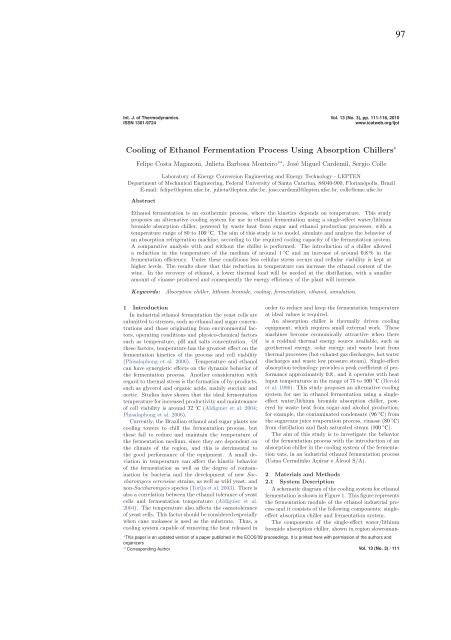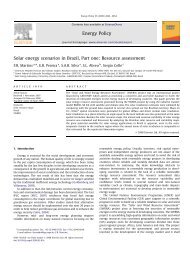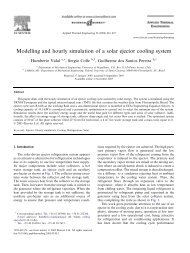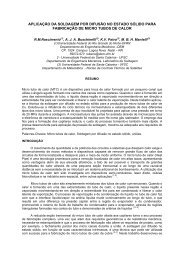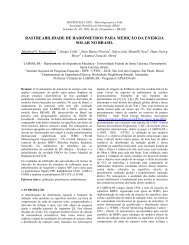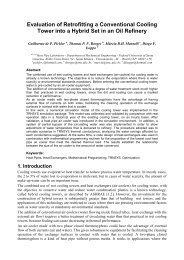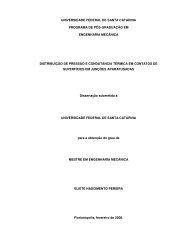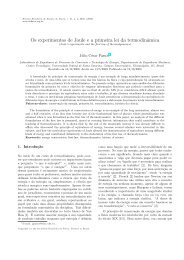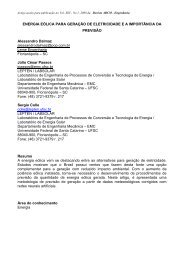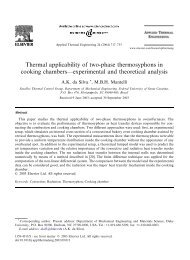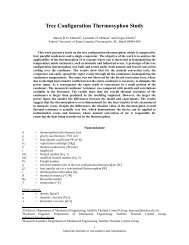analise dinâmica de um chiller de absorção de brometo de lítio ...
analise dinâmica de um chiller de absorção de brometo de lítio ...
analise dinâmica de um chiller de absorção de brometo de lítio ...
- No tags were found...
You also want an ePaper? Increase the reach of your titles
YUMPU automatically turns print PDFs into web optimized ePapers that Google loves.
97Int. J. of ThermodynamicsISSN 1301-9724Vol. 13 (No. 3), pp. 111-118, 2010www.icatweb.org/ijotCooling of Ethanol Fermentation Process Using Absorption Chillers ∗Felipe Costa Magazoni, Julieta Barbosa Monteiro ∗∗ ,José Miguel Car<strong>de</strong>mil, Sergio ColleLaboratory of Energy Conversion Engineering and Energy Technology - LEPTENDepartment of Mechanical Engineering, Fe<strong>de</strong>ral University of Santa Catarina, 88040-900, Florianópolis, BrazilE-mail: felipe@lepten.ufsc.br, julieta@lepten.ufsc.br, jose.car<strong>de</strong>mil@lepten.ufsc.br, colle@emc.ufsc.brAbstractEthanol fermentation is an exothermic process, where the kinetics <strong>de</strong>pends on temperature. This studyproposes an alternative cooling system for use in ethanol fermentation using a single-effect water/lithi<strong>um</strong>bromi<strong>de</strong> absorption <strong>chiller</strong>, powered by waste heat from sugar and ethanol production processes, with atemperature range of 80 to 100 ◦ C. The aim of this study is to mo<strong>de</strong>l, simulate and analyze the behavior ofan absorption refrigeration machine, according to the required cooling capacity of the fermentation system.A comparative analysis with and without the <strong>chiller</strong> is performed. The introduction of a <strong>chiller</strong> alloweda reduction in the temperature of the medi<strong>um</strong> of around 1 ◦ C andanincreaseofaround0.8% in thefermentation efficiency. Un<strong>de</strong>r these conditions less cellular stress occurs and cellular viability is kept athigher levels. The results show that this reduction in temperature can increase the ethanol content of thewine. In the recovery of ethanol, a lower thermal load will be nee<strong>de</strong>d at the distillation, with a smalleramount of vinasse produced and consequently the energy efficiency of the plant will increase.Keywords:Absorption <strong>chiller</strong>, lithi<strong>um</strong> bromi<strong>de</strong>, cooling, fermentation, ethanol, simulation.1 IntroductionIn industrial ethanol fermentation the yeast cells aresubmitted to stresses, such as ethanol and sugar concentrationsand those originating from environmental factors,operating conditions and physico-chemical factorssuch as temperature, pH and salts concentration. Ofthese factors, temperature has the greatest effect on thefermentation kinetics of the process and cell viability(Phisalaphong et al. 2006). Temperature and ethanolcan have synergistic effects on the dynamic behavior ofthe fermentation process. Another consi<strong>de</strong>ration withregard to thermal stress is the formation of by-products,such as glycerol and organic acids, mainly succinic andacetic. Studies have shown that the i<strong>de</strong>al fermentationtemperature for increased productivity and maintenanceof cell viability is around 32 ◦ C (Aldiguier et al. 2004;Phisalaphong et al. 2006).Currently, the Brazilian ethanol and sugar plants usecooling towers to chill the fermentation process, butthese fail to reduce and maintain the temperature ofthe fermentation medi<strong>um</strong>, since they are <strong>de</strong>pen<strong>de</strong>nt onthe climate of the region, and this is <strong>de</strong>trimental tothe good performance of the equipment. A small <strong>de</strong>viationin temperature can affect the kinetic behaviorof the fermentation as well as the <strong>de</strong>gree of contaminationby bacteria and the <strong>de</strong>velopment of new Saccharomycescerevisiae strains, as well as wild yeast, andnon-Saccharomyces species (Torija et al. 2003). There isalso a correlation between the ethanol tolerance of yeastcells and fermentation temperature (Aldiguier et al.2004). The temperature also affects the osmotoleranceof yeast cells. This factor should be consi<strong>de</strong>red especiallywhen cane molasses is used as the substrate. Thus, acooling system capable of removing the heat released inor<strong>de</strong>r to reduce and keep the fermentation temperatureat i<strong>de</strong>al values is required.An absorption <strong>chiller</strong> is thermally driven coolingequipment, which requires small external work. Thesemachines become economically attractive when thereis a residual thermal energy source available, such asgeothermal energy, solar energy and waste heat fromthermal processes (hot exhaust gas discharges, hot waterdischarges and waste low pressure steam). Single-effectabsorption technology provi<strong>de</strong>s a peak coefficient of performanceapproximately 0.8 , and it operates with heatinput temperatures in the range of 75 to 100 ◦ C (Herol<strong>de</strong>t al. 1996). This study proposes an alternative coolingsystem for use in ethanol fermentation using a singleeffectwater/lithi<strong>um</strong> bromi<strong>de</strong> absorption <strong>chiller</strong>, poweredby waste heat from sugar and alcohol production,for example, the contaminated con<strong>de</strong>nsate (96 ◦ C)fromthe sugarcane juice evaporation process, vinasse (80 ◦ C)from distillation and flash saturated steam (100 ◦ C).The aim of this study is to investigate the behaviorof the fermentation process with the introduction of anabsorption <strong>chiller</strong> in the cooling system of the fermentationvats, in an industrial ethanol fermentation process(Usina Cerradinho Açúcar e Álcool S/A).2 Materials and Methods2.1 System DescriptionA schematic diagram of the cooling system for ethanolfermentation is shown in Figure 1. This figure representsthe fermentation module of the ethanol industrial processand it consists of the following components: singleeffectabsorption <strong>chiller</strong> and fermentation system.The components of the single-effect water/lithi<strong>um</strong>bromi<strong>de</strong> absorption <strong>chiller</strong>, shown in region slowroman-∗ This paper is an updated version of a paper published in the ECOS’09 proceedings. It is printed here with permission of the authors andorganizers∗∗ Corresponding Author Vol. 13 (No. 3) / 111


